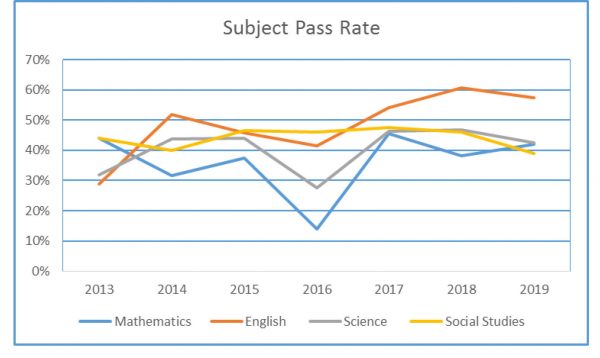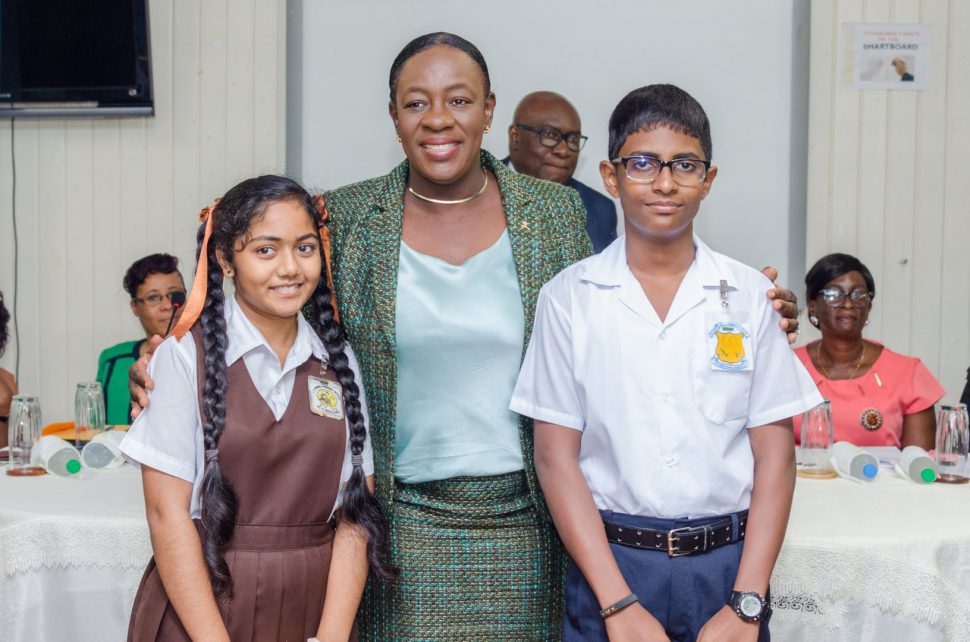There has been a marginal increase in the Mathematics pass rate at this year’s National Grade Six Assessment (NGSA) but overall, students continue to fail the subject as well as Science and Social Studies. In fact the pass rate for every subject except Mathematics has decreased in 2019.
In English a 2018 pass rate of 60.6% decreased to 57.4%, in Science 42.4% of candidates scored 50% or more compared with 46.8% while Social Studies recorded an abysmal 39% pass rate, its lowest in at least six years.
Minister of Education Dr. Nicolette Henry while presenting the results yesterday stressed that there had been improved performances in Mathematics across all Regions while Chief Education Officer Marcel Hutson acknowledged that the recent hyper-focus on Math may have had detrimental impacts on other subject areas.
“This year we have seen improved performance in Mathematics in all of the regions, with the most notable improvement being in Regions Two, Three and Eight and I am really pleased to see that in the particular case of Region Eight, they have actually doubled their performance from last year,” Henry noted.
Region Eight recorded a 19.1% pass rate in Math while Regions two and three recorded pass rates of 38.3% and 51.7% respectively.
The Minister credited this performance to the continued implementation of the Emergency Mathematics Intervention Plan. The $49 million plan. According to the Ministry this resulted in an across-the-board improvement in 2017. This improvement, a 46.6% overall pass rate, has however proved difficult to maintain.
The Ministry however remains optimistic that these are signs of possible long-term success.
“Moving from 13.8 to 40 percent is remarkable,” the Minister enthused adding that the ministry has noticed that in ten of the eleven education districts, “candidates were able to secure places at the top five secondary schools in the capital city of our beautiful country.”
“This of course is a good sign and certainly an indicator that reducing the disparities in education delivery between the hinterland and the coastland region is beginning to take some form,” she said.
The district which was unable to secure a place at a top secondary school was Region One whose top student Shemmol Chan managed to secure a place at Santa Rosa Secondary with a score of 496.
Region One, which fielded a total of 978 candidates at this year’s assessments recorded the lowest pass rates in every subject area. In Mathematics a mere 15.6% secured 50% or more, in English the pass rate was 29.8%, in Science 14.5% and in Social Studies 11.6%.
Three other hinterland districts, Regions Seven, Eight and Nine, also consistently performed below average.
While an overall pass rate was not shared with the public, the Minister stated that over the last five years a positive trend has been seen with the number of candidates who would have scored below 20% decreasing.
“In fact in English, Mathematics and Science we have seen that a majority of our students are able to gain more than 45%,” she shared.
Though the Minister also claimed that there has been “more competition between the public and private schools for top positions” once again the data did not support this conclusion. In reality less than 30% of the 166 students in the top 1% attended a public primary school. Numbers in 2018 were similar with 56 out of 174 students or 32% of the top 1% having attended public schools.
Schools such as Leonora Primary and Stella Maris Primary which once dominated the list now make sporadic appearances. In fact former juggernaut St Margaret’s Primary managed only one appearance while West Ruimveldt Primary did not appear at all.
This year 14,300 students sat exams on the 17th and 18th of April. The Ministry continued its collaboration with the Caribbean Examination Council (CXC) to improve the quality of the assessments as such teachers, subject specialists and test development officers developed the test items with the technical guidance of CXC. They addressed key areas such as item construction, weighting of items, sampling and other psychometric elements in four subjects namely Mathematics, English, Science and Social Studies. The examination in each subject area consisted of two papers. Paper one consisted of forty multiple choice items while Paper Two consisted of essay-type or open-ended items.
The highest attainable score in Social Studies was 138, in Science it was 135, in Mathematics it was 133, while the maximum attainable score in English was 130. The maximum attainable score was therefore 536
Areas tested for each subject include knowledge, algorithmic thinking and reasoning for Mathematics; knowledge, comprehension and application for Science; knowledge, conceptual understanding and use of knowledge for Social Studies; and reading, comprehension and vocabulary, structure and mechanics, content, focus, vocabulary language and organisation for English language.







